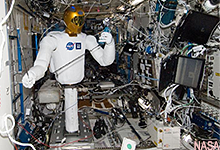Robonaut 2 gets its space legs


Connecting state and local government leaders
Robonaut's new legs have prehensile feet, which will give it an edge over humans, letting it climb ladders while its hands are free to work or hold objects.
What is arguably the most sophisticated humanoid robot just got a present delivered by a SpaceX rocket: a set of legs.
Robonaut 2, which has been operating on the International Space Station for the past three years, has until now been just a torso with a head and arms planted on a pedestal with wheels.

Controlled by teams on the ground, Robonaut 2 humanoid robot holds an instrument to measure air velocity during another system check out in the Destiny laboratory of the International Space Station.
Designed to work in a human's world, Robonaut’s head has cameras that work like human eyes. Its hands work like a human’s to use the same tools that the astronauts do.
As envisioned, Robonaut would help people working in space “with the same interface systems as humans," said Robert Ambrose, chief of the Software, Robotics and Simulation Division at NASA's Johnson Space Center and a primary developer of Robonaut.
Robonaut even sent its first tweet on July 26, 2010, with the help of its team.
Robonaut can be programmed to perform tasks on its own, or a human can take direct control, viewing what the robot "sees" through its cameras and controlling its movements.
One of the major challenges in developing Robonaut was, of course, being able to replicate human movements. "A key challenge was being able to handle objects that were built for people," Ambrose said. "Most robots don't even have a thumb, right?"
Another hurdle was ensuring the safety of astronauts working next to Robonaut.
That challenge was addressed with the use of redundant sensors in Robonaut that detect contact. "If the robot is minding its own business and you bump into it, it can sense that," Ambrose said. "If it's in motion and bumps into something else with a force below a certain threshold, it pauses. Above a certain threshold, it shuts itself off."
"That's the biggest breakthrough for Robonaut," Ambrose said. "It is the first robot that is ever been allowed to operate right next to people where it is responsible for its own safety system.”
Also, Ambrose added, "Robonaut is very smooth. A lot of robots have angles and sharp edges. We've been very careful to make everything smooth."
Robonaut's new legs will allow it to move about inside and outside the space station to perform tasks, such as checking the many air filters on the Space Station. In fact, Robonaut's legs, which have prehensile feet, will give it an edge over the humans on board, letting it climb ladders while its hands are free to work or hold objects.
Once fully developed, Ambrose said, the robot might be sent on missions ahead of humans, or be left behind as a caretaker, waiting for the next crew to arrive. "A robot doesn't mind being left behind," he noted. "It doesn't get lonely, so you can do things with a robot you would never do with the human crew."
"These robots are just going to get better and better," Ambrose said, adding that Robonaut will eventually have many terrestrial applications. "Robots will get more capable electrically and mechanically, but they're also going to get smarter."
NEXT STORY: UMD establishes orbital debris research center




